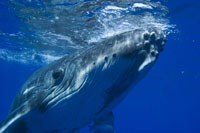US Navy wins legal permission to hardm whales with low-frequency sonars
The U.S. government wants to extend by five years its rules allowing the Navy to use a new low-frequency sonar, despite objections from environmentalists that the technology may harm whales and dolphins.

The National Oceanic and Atmospheric Administration said Tuesday that the low-frequency active sonar used to detect submarines at great distances would have a "negligible impact" on marine mammals species and stocks.
The Navy, in requesting the five-year rule extension, asked for permission to use the sonar in the Pacific, Atlantic and Indian oceans, as well as in the Mediterranean Sea, NOAA said in a document submitted to the Federal Register.
NOAA has opened its proposal for the five-year rule extension to public comment through July 24. It will issue a final decision on the extension after reviewing any submitted comments. The current rules expire Aug. 16.
The Natural Resources Defense Council, which challenged the low-frequency rules when they were first established five years ago, said it was disappointed with NOAA's move.
"This particular system generates noise pollution over a staggering geographic scale," said Joel Reynolds, a council attorney. Reynolds said the council plans to sue again if NOAA finalizes the rule extension.
Scientists say sonar may mask the echoes some whales and dolphins listen for when they use their own natural sonar to locate food. Navy sonar may also startle some species, in particular beaked whales, prompting them to rush to the surface with dangerous consequences.
The current rules require sailors to shut down their sonar when marine mammals are nearby and adopt other measures to protect the animals.
Mark Matsunaga, a U.S. Pacific Fleet spokesman, said the Navy is happy with the NOAA decision. "We had requested the extension and we're pleased," Matsunaga said.
Low-frequency active sonar is operationally available on only two ships the Navy uses. Those vessels are in the Western Pacific, and they have not been allowed to use such sonar near the Hawaiian Islands.
The low-frequency active sonar is a newer technology than mid-frequency active sonar, which the Navy has installed on many of its submarines and other vessels.
In both cases, sailors pump sound into the water and listen for any objects the sound waves bounce off of. Low-frequency active sonar, however, travels greater distances than the other variety, and environmentalists say it poses a greater danger to marine mammals.
Subscribe to Pravda.Ru Telegram channel, Facebook, RSS!


